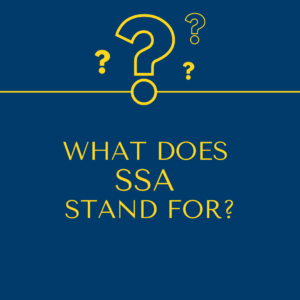 When looking into disability, retirement, or survivors’ benefits, you might have encountered the acronym SSA. Knowing what the SSA does is important if you apply for government benefits or enroll in Medicare.
When looking into disability, retirement, or survivors’ benefits, you might have encountered the acronym SSA. Knowing what the SSA does is important if you apply for government benefits or enroll in Medicare.
What Is the SSA?
SSA stands for the Social Security Administration. The Social Security Administration is an agency of the federal government.
This agency issues Social Security numbers. Your Social Security number is your unique identifier to access government benefits and services. It also runs the nation’s Social Security programs.
Following the Great Depression, President Franklin D. Roosevelt sought to create federal social insurance programs to benefit people in need. This included retired workers, the unemployed, and individuals who were unable to work due to a disability. Consequently, the Social Security Act was passed in 1935.
Programs the SSA administers today include the following:
- Social Security retirement benefits
- Social Security Disability Insurance (SSDI)
- Supplemental Security Income (SSI)
- Medicare
- Medicaid
- Veterans’ benefits
Who Qualifies for Social Security?
Depending on the program, Social Security can benefit older adults, those with limited income and resources, people with disabilities, or their family members. Beneficiaries receive monthly payments that the SSA distributes.
Here is an overview of a few of these programs:
Social Security Retirement
When you retire or reduce your hours as you approach the SSA’s “full” retirement age, Social Security retirement benefits could provide you with a monthly payment that replaces or supplements your income. If you worked long enough and paid Social Security taxes, you may qualify for these benefits.
Your employer likely includes these taxes as part of your paycheck, entitling you to Social Security benefits in the future. Or, you might have handled these taxes yourself if you were self-employed.
In 2023, the average Social Security retirement payment for retired workers is $1,830 per month.
Social Security Disability Insurance
In the event that you become disabled and cannot work, you could receive Social Security Disability Insurance (SSDI). To obtain coverage, you must have worked long enough to have made sufficient contributions to Social Security. Note that adults with disabilities whose parents paid into Social Security during their working years may also be eligible.
SSDI applicants must also meet the SSA’s strict definition of disability.
The SSA’s Definition of Disability
According to the SSA, disability is defined as “the inability to do any substantial gainful activity by reason of any medically determinable physical or mental impairment.” In other words, your condition must render you unable to work. Your disability must also last at least a year or be terminal.
In 2023, the average SSI payment is $1,483 per month. Note that the SSA relies on a formula, based in part on your lifetime earnings, to calculate your monthly SSDI benefit.
Supplemental Security Income
Supplemental Security Income (SSI) benefits older adults with limited means as well as low-income people with disabilities. SSI differs from SSDI in that, to qualify, you must have limited income and assets (generally less than $2,000).
There is also no requirement that you must have worked and paid into Social Security. A person with a disability who has never worked could qualify for SSI. Older adults with low incomes and few resources can also receive SSI, even if they do not have a disability. They must be 65 or older.
In most states, you also receive public health insurance, called Medicaid, with SSI.
The average SSI monthly payout in 2023 is $914 for an individual.
Medicare
Medicare is public health insurance for older adults. While the Centers for Medicare and Medicaid Services (CMS) primarily administers Medicare, the SSA also plays a role by handling Medicare enrollment.
- If you already get Social Security benefits, the SSA sends you a Medicare enrollment package before you turn 65. When you turn 65, the SSA will automatically enroll you in Medicare Part A hospital coverage and Medicare Part B medical insurance.
- If you have a disability, the agency will enroll you in Medicare even if you are younger than 65 after you have received SSDI payments for two years.
The SSA deducts Medicare Part A and B premiums directly from Social Security benefits. (Few people have to pay a premium for Part A.)
- Some choose to enroll in Medicare Part D, which covers prescription drugs. The SSA can also deduct your Part D premium if you wish.
Questions?
Social Security programs, including SSI, SSDI, and others, follow very complex rules. If you are not sure how to apply for one of these programs, want to determine whether you are eligible, or have other questions, consult with a qualified special needs planner near you.

Recent Comments